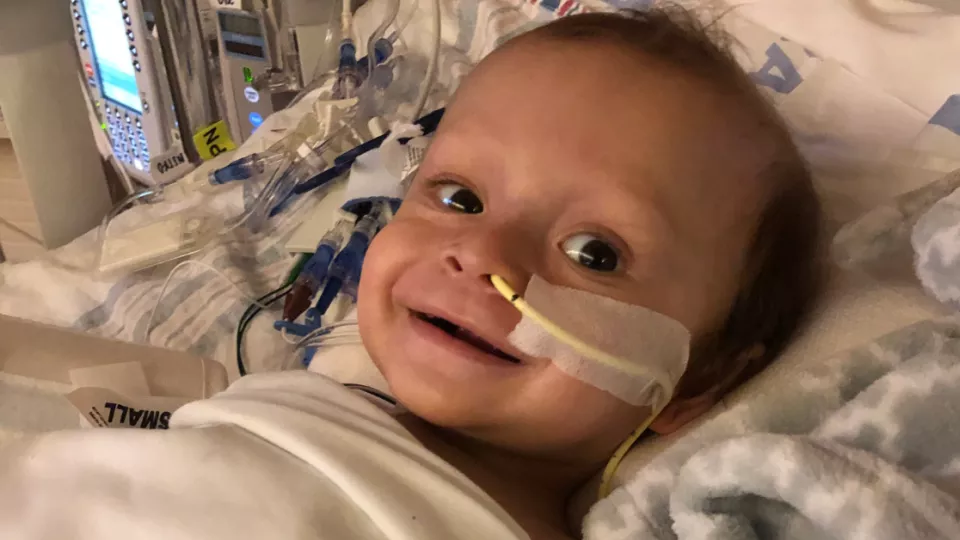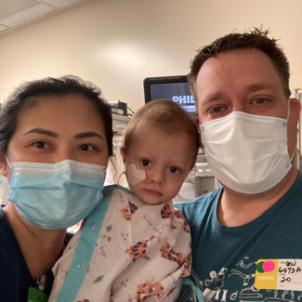
Children’s Hospital Los Angeles Performs 400th Pediatric Liver Transplant
Los Angeles (Dec. 23, 2020) – One-year-old Jacob Cooper loves clapping his hands, blowing bubbles and looking at the pictures in his new Buzz Lightyear book. But his favorite thing is simply to smile.
“He is super happy,” says his father, Chad. “He finds joy in everything. He smiles and then you smile, and it’s contagious.”
These days, Jacob and his parents, Aileen and Chad, have a lot to be happy about. That’s because on Oct. 20, Jacob received a new liver. The lifesaving surgery also marked the 400th pediatric liver transplant at Children’s Hospital Los Angeles (CHLA) —a major milestone that only a handful of hospitals in the country have reached.
“It speaks to the depth and experience of our liver transplant team and of the entire institution,” says Yuri Genyk, MD, Chief of the Division of Abdominal Transplantation at Children’s Hospital Los Angeles, who has led the hospital’s Liver and Intestinal Transplant Program since its founding. “So many people from across the hospital come together every day to provide outstanding care for these patients. It’s an enormous team effort.”
But the number isn’t the only thing that makes this transplant extra special. The person who donated that tennis-ball-sized section of liver, Mike Speck, traveled all the way from Sandusky, Ohio—in the midst of the COVID-19 pandemic—and underwent a four-hour surgery to give Jacob a second chance at life.
“I was truly speechless,” says Chad. “It was not something I’d thought of, that a stranger was going to come across the country to save my son’s life.”
Expertise in living donors
The Liver and Intestinal Transplant Program at Children’s Hospital Los Angeles began in 1998 and now performs 25 to 30 liver transplants each year—the most in Southern California—with survival rates exceeding national averages.
About one-third of those transplants come from living donors, making Children’s Hospital Los Angeles one of the top five programs in the nation for living donor liver transplants in pediatrics.
Outcomes for living donor transplants—especially in children—are generally better than for those who receive livers from cadaveric donors. Living donation also allows patients to get a new organ much sooner.
“It cuts down on the wait time significantly,” says Rohit Kohli, MBBS, MS, Chief of the Division of Gastroenterology, Hepatology and Nutrition. “Because of our strength in living donation, our average wait time for a transplant is 2.6 months, compared with 10 months nationally.”

That’s important because children with liver failure don’t have time to wait.
“With end-stage liver disease, you don’t get sick gradually; you fall off a cliff,” says Dr. Genyk. “We try to stay ahead of that event. We want to do the transplant before the patient’s condition really deteriorates.”
Jacob had been getting sicker throughout the summer and early fall. He was born with biliary atresia, a condition in which the liver’s bile ducts are blocked or underdeveloped. The family lives in Imperial County, and they were referred to Children’s Hospital Los Angeles in June for a transplant.
At first, Chad was going to be the donor. He was a match, but after he went through a series of medical tests, doctors made a shocking discovery: a tumor was growing in Chad’s abdomen. Not only was he now ineligible to donate to his son, but the family had a second medical crisis to deal with.
Then, on Oct. 12, their luck turned around. The family got a surprise call from Children’s Hospital Los Angeles about an anonymous donor. Such altruistic donors are rare; there have been 11 in the program’s history. Although the liver regenerates in about two months, donors have to endure major surgery and a weeks-long recovery.
On the day of the transplant, the two surgeries—one for the donor at Keck Medicine of USC, and one for Jacob at Children’s Hospital Los Angeles—took a combined 13 hours. Dr. Genyk led both surgical teams—something he’s done since 1998.
A month later, the Coopers were able to meet Speck and his wife, Genevieve, via an emotional Zoom call.
“He gave part of his liver to our son,” Aileen says. “He’s a miracle. He’s a blessing to our family.”
Making livers last
Like Jacob, about half of children who receive liver transplants at Children’s Hospital Los Angeles are under age 2. A major focus for the team is conducting leading-edge research—in partnership with The Saban Research Institute of Children’s Hospital Los Angeles—into how to make those new livers last a lifetime.
Meanwhile, the Coopers are looking forward to a healthy future for Jacob—and for Chad. In November, Chad’s tumor, which was not cancerous, was completely removed in San Diego. Both he and Jacob are doing great.
That’s a lot of reasons for Jacob—and his whole family—to smile.
“It’s such a blessing to be back to our normal life and to have Jacob healthy,” says Aileen. “We are so thankful to Dr. Genyk and all the doctors and nurses at Children’s Hospital Los Angeles for everything they have done to support us.”
About Children's Hospital Los Angeles
Founded in 1901, Children's Hospital Los Angeles is the highest-ranked children’s hospital in California and fifth in the nation on the prestigious U.S. News & World Report Honor Roll of Best Children’s Hospitals. U.S. News ranks Children’s Hospital Los Angeles in all 10 specialty categories. Clinical care at the hospital is led by physicians who are faculty members of the Keck School of Medicine of USC through an affiliation dating from 1932. The hospital also operates the largest pediatric residency training program at a freestanding children’s hospital in the Western United States. The Saban Research Institute of Children’s Hospital Los Angeles is home to all basic, translational, clinical and community research conducted at the hospital, allowing proven discoveries to quickly reach patients. Our mission: to create hope and build healthier futures. To learn more, follow us on Facebook - Opens in a new window, Instagram - Opens in a new window, LinkedIn - Opens in a new window, YouTube - Opens in a new window and Twitter - Opens in a new window, and visit our blog at CHLA.org/blog.


